Click returns
Page 52

Page 53

If you've noticed an error in this article please click here to report it so we can fix it.
Vanheim Auctions' commercial
vehicle sales director Alex Wright
looks back at the close of 2007, when supply and demand led to
stability in used van prices.
Due to seasonal factors, used van values at the tail end of last year remained stable, and similar to November's. That Was due largely to the volume of stock,which was at its highest level for over a year.With effectively only two weeks' worth of trading in December, a comprehensive sector analysis is of little value; instead we have looked at the overall period and its activity instead.
Traditionally. buyers use December and January to reflect upon the previous year with an eye on stock levels, enquiries taken/ converted and, importantly. they take the opportunity to network with fellow dealers, auctioneers and dedicated CV auction teams about the state of the market.
At the time of writing (midJanuary) this has been borne out by large buyer attendances at all seven dedicated Manheim CV auction centres. Seasonal influences can affect auction sale performance regionally, and for a broader perspective, Manheim's CV team observes, analyses and communicates these regional variations This tends to bring a greater measure of stability and confidence to the CV marketplace.
Economic uncertainty
Buyers are reporting that an increasing number of retail customers are uncertain about the economic climate.When this has happened in the past, the selfemployed market has adopted a pragmatic outlook on purchasing, preferring instead to consider vans with a lower price ceiling.
Lower-value vans can be paid for with cash reserves rather than finance; historically, the price ceiling hovers around the £4,000 mark.This is not to say that vans above that price struggle — instead, traders will stock sub£4,000 vans, preferring and choosing to buy any more expensive stock to order.
Driving forward
As a CV market maker, Manheim continually works hard to demonstrate how proactive it is at driving its business forward. It would be unprofessional — but all too easy — to have a challenging sale and simply blame the market.
It is therefore Manheim's ultimate responsibility to know the market and look at the past to predict the future and the potential market performance.
Listening to buyers nationwide at this time of the year provides Manheim with a true reflection of the market, allowing it to he proactive with information for our vendors' benefit. In December, the feedback I received from buyers was that retail sites are reporting regional differences.
A large proportion of dealers in built-up areas are riding out the storm, along with their counter parts with established rural sites.
Throughout 2006 and 2007, tvlanheirri buyers reported that the strength of the CV market, and achieved values, seemed unsustainable.Yet they carried on. In the past 18 months, driven entirely by supply and demand, there has been a flattening, or lessening, of the vans' depreciation curves.At some point a market realignment will get it back on track.
The key to success as a vendor or buyer is to be close to the market, ensuring cashflow is a primary focus and that your preferred auction company is demonstrably doing everything possible to create an environment in which to do business.
CV Live is a great example of this, as it maximises the productivity of buyers and opens the market to the widest possible customer base. In this way Manheim's vendors can be reassured we are working hard to achieve the hest market value on the day.And that's important when they report back to their businesses on auction performance. •








































































































































































